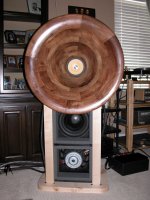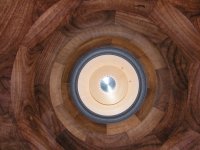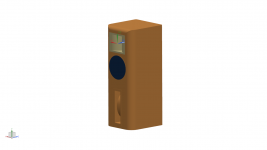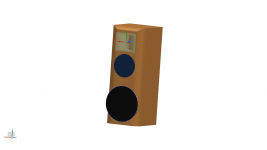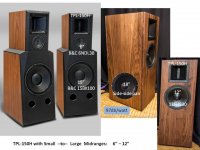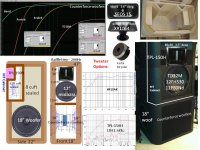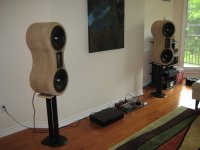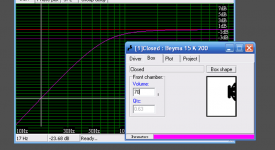A very nice looking driver. Using the leading edge of the response dip at 2200Hz and adding a quick 2nd order would probably be the highest I'd take it. Maybe it should be crossed closer to 1500Hz in this case.
I'm assuming the tweeter waveguide is around 30cm high. This could be enough when it's baffled in, but 30 degrees is fairly narrow and it may want to be longer or higher. H looks OK.
I'm assuming the tweeter waveguide is around 30cm high. This could be enough when it's baffled in, but 30 degrees is fairly narrow and it may want to be longer or higher. H looks OK.
Have you considered that maybe a pair of 8", maybe 10" in am MTM might match directivity of the TPL at a sub 2000Hz crossover?
Hello Allen. I've been going in circles with this idea as well. My thinking is a 6.5" driver matches the 80 degree directivity of the TPL with waveguide pretty well at 2kHz, so a couple of 6.5" vs a single 10" midrange (2.2 vs 1.8kHz xo, approx).
The waveguide in the TPL is 23cm high so presents a challenge for MTM without lobbing. At least that is what models show. How perceivable is that effect? I don't know. I've seen a comment by Overkill saying it's overated. I dunno.
Here's a design that does this and claims good results: Ground Sound
What do you mean by this?
They should then match a 180 degree bass presentation a couple of octaves below if you size the baffle appropriately. (and radius it).
Lobing is overrated. Not that it's not a problem, maybe a little misunderstood.
It seems with horns that it's difficult to get the drivers close, but, say you'd expect a null at +60 degrees, and the horns are only playing out to 45 degrees. Nothing will come of it. It could even be used to trim directivity around a crossover.
At the higher frequencies of an upper crossover, sound that travels upward should be expected to add to the reverberent field (good), and to give you a discrete ceiling reflection along the way. One of the better ways to deal with this reflection is to treat it on the ceiling, and once it's treated the lobing issue becomes a non issue.
I have made use of a 10 degree frontal (V) lobe. It was all I was getting with one driver arrangement I was using. I needed to align the listening axis phase to direct the lobe there and that's it, well most of it, power response shouldn't fall too far behind but it's a lower priority.
I think it is interesting to compare this to taking a sweep of each driver from the listening position and varying the gating to watch the reflections coming in. Their nature, timing, level, what walls etc as it can be different between drivers.
It seems with horns that it's difficult to get the drivers close, but, say you'd expect a null at +60 degrees, and the horns are only playing out to 45 degrees. Nothing will come of it. It could even be used to trim directivity around a crossover.
At the higher frequencies of an upper crossover, sound that travels upward should be expected to add to the reverberent field (good), and to give you a discrete ceiling reflection along the way. One of the better ways to deal with this reflection is to treat it on the ceiling, and once it's treated the lobing issue becomes a non issue.
I have made use of a 10 degree frontal (V) lobe. It was all I was getting with one driver arrangement I was using. I needed to align the listening axis phase to direct the lobe there and that's it, well most of it, power response shouldn't fall too far behind but it's a lower priority.
I think it is interesting to compare this to taking a sweep of each driver from the listening position and varying the gating to watch the reflections coming in. Their nature, timing, level, what walls etc as it can be different between drivers.
I think vinylnvalves has the right idea about the waveguide. Better to make it right than to compromise. What you lose in driver spacing could be had back if you can cross lower, or worth it just for better integration, or for lower diffraction and at lower frequencies provided the driver can handle it.2kHz
What did I mean about the bass? Say the job of the mids is to cover from the tweeter down to the room frequency. It would need to change from 80x30 to something useful for the woofers, say 180 axis-symmetrical, which it would do just about by the time it gets to the room frequency.
If you make the baffle narrow, the directivity at lower mid frequencies is going to become rectangular again, though I doubt it would matter as much as for the upper crossover.
Got arround to over the weekend trying out the deltalites in the OB hornloaded bass. Sounds very similar to the Seliniums, measures similar as well flat to 55Hz then dips (used the same EQ), doesn't have the sparkle in the lower octaves i desire. Been thinking and it seems there are two options that should be ease to integrate with the TPL.
I have attached a couple of CAD rendered images of my throughts.
The first is a PPSL (sealed?) to cover upto 100Hz, where a mid range takes over.
Reckon i could get away with a pair of 15" for this - recommendations for a suitable (Qts=0.31) driver?
The second is just an 18" in a sealed baffle, covering up to 100hz again, (similar to the Daniel Hertz M1?).
Looked at modelling a PPSL in Hornresp, tried modelling to a qtc of 0.7, not sure if this is the right approach or not. (my make a test cabinet for the deltalites to see if PPSL is all its meant to be.
With regard to an 18" sealed driver, i have the offer of a couple of 18 sound 18nd9100, which i think is like the 18w1000, light cone, big BL, at a good price. I know a pair of counter force drivers have been recommended, however i reckon, trading the cabinet resonance against volume and cost, if i can control the resonances then it looks a good compromise. (I am an aerospace engineer). I have looked at the beyma 18" range and cannot find a light coned driver, all seem to be 200grams +.
I have attached a couple of CAD rendered images of my throughts.
The first is a PPSL (sealed?) to cover upto 100Hz, where a mid range takes over.
Reckon i could get away with a pair of 15" for this - recommendations for a suitable (Qts=0.31) driver?
The second is just an 18" in a sealed baffle, covering up to 100hz again, (similar to the Daniel Hertz M1?).
Looked at modelling a PPSL in Hornresp, tried modelling to a qtc of 0.7, not sure if this is the right approach or not. (my make a test cabinet for the deltalites to see if PPSL is all its meant to be.
With regard to an 18" sealed driver, i have the offer of a couple of 18 sound 18nd9100, which i think is like the 18w1000, light cone, big BL, at a good price. I know a pair of counter force drivers have been recommended, however i reckon, trading the cabinet resonance against volume and cost, if i can control the resonances then it looks a good compromise. (I am an aerospace engineer). I have looked at the beyma 18" range and cannot find a light coned driver, all seem to be 200grams +.
Attachments
Doug's thread "10" MTM with NeoPro5i Ribbon - Build Thread" is a good reminder of dispersion and lobing limitations in an MTM when the M-M center-to-center spacing is greater than half the crossover frequency wavelength. Doug's summary:
"1. Unacceptable vertical response caused by the MTM arrangement of the TD10M drivers.
The drivers ended up being spaced about 18” apart C-C to make room for the NeoPro5i in between. That 18” spacing corresponds to a wavelength of 750Hz which means the first serious null would be around 1500Hz. If you take a look at the vertical response of the two TD10M drivers in their MTM arrangement, you’ll see the severity of the problem. At just 15 degrees off axis, there’s a 20dB dip at 1500Hz which is completely unacceptable. Things only get worse from there, with a plethora of peaks and nulls as you move farther off axis."
======
The latest TPL-150H designs in diyAudio are TMW, or TM-WW for higher efficiency bass. The debate continues on the best T-M crossover frequency between 1600Hz and 2000Hz, and this will decide the midrange size which can match the 80-degree TPL-150H horn at the crossover frequency. A custom built TPL horn with 60H x 30V has been used to provide a better polar match from the narrower sound stage to select 12" midbass at-and-above 1600Hz.
"1. Unacceptable vertical response caused by the MTM arrangement of the TD10M drivers.
The drivers ended up being spaced about 18” apart C-C to make room for the NeoPro5i in between. That 18” spacing corresponds to a wavelength of 750Hz which means the first serious null would be around 1500Hz. If you take a look at the vertical response of the two TD10M drivers in their MTM arrangement, you’ll see the severity of the problem. At just 15 degrees off axis, there’s a 20dB dip at 1500Hz which is completely unacceptable. Things only get worse from there, with a plethora of peaks and nulls as you move farther off axis."
======
The latest TPL-150H designs in diyAudio are TMW, or TM-WW for higher efficiency bass. The debate continues on the best T-M crossover frequency between 1600Hz and 2000Hz, and this will decide the midrange size which can match the 80-degree TPL-150H horn at the crossover frequency. A custom built TPL horn with 60H x 30V has been used to provide a better polar match from the narrower sound stage to select 12" midbass at-and-above 1600Hz.
Attachments
And other two.
Are those Sierra-Brooks horns ? They certainly are beautiful, just like the S-B
models of years past, were.
I can't ever remember seeing a model with a large throat for a cone driver.
Does that driver (which is it?) cover all the way up to give you enough highs ?
Also, it looks like you have Danny Richie's servo di-pole beneath !
Mr. Lewinsky, if you are also reading this, have you pondered on a large round horn like this, for mid range ?
Are those Sierra-Brooks horns ? They certainly are beautiful, just like the S-B
models of years past, were.
I can't ever remember seeing a model with a large throat for a cone driver.
Does that driver (which is it?) cover all the way up to give you enough highs ?
Also, it looks like you have Danny Richie's servo di-pole beneath !
Mr. Lewinsky, if you are also reading this, have you pondered on a large round horn like this, for mid range ?
Of course I am, Scott!
Those are pretty. I'm guessing I would have a tough time selling them to my wife, though.
I know close to nothing about horns, but wouldn't it be a challenge in terms of center-to-center distance between a horn like than and a TPL?
The choice seems to keep coming back to a TMW, or TM-WW. I like the idea of the WW but am worried that it may be to much for my small room if i use 18" drivers, as i have mentioned before. Maybe i buy a pair of the 18" faitals and try then in WW and if its to much i can use then as singles in sealed cabinets?
I cane across the specs for the Beyma SM118/n recently - seems to be a reasonably light cone with a high qts, Fs is a little high at 42hz, but does this matter if you equalise the response?
I cane across the specs for the Beyma SM118/n recently - seems to be a reasonably light cone with a high qts, Fs is a little high at 42hz, but does this matter if you equalise the response?
BIG is relative. You already have a 28"wide 23"deep JMCL midrange horn pushed against the walls in your small room.
Maybe....
1) sketch a few woofer cabinet shapes that provide 6-7-8 cuft of volume. A rectangular cabinet with a center opening for the REAR of the JMLC horn might allow a modest footprint and not stand much higher than the JMLC top.
2) consider how you could replace the JMLC with the TPL-150H plus a 10"-12" sealed midrange(~1.3 cuft). gives you options. A small waveguide with the JBL CMCD 8" midrange is another future option. (small horns in a small room pic)
The SM118 with Fs~42hz and Qts~0.6 would not be my top choice for a woofer chartered to reproduce 27.5Hz piano low A. Fs <30hz, Qtc~0.37, Mms <200g models well sealed box + modest boost. A 15" with the proper T/S specs can sound better than a poor T/S spec 18" woof. BUT
==== Sd vs. cone diameter===
18" 1220 cm2
15" 855 cm2
12" 530 cm2
10" 345 cm2
8" 225 cm2
Maybe....
1) sketch a few woofer cabinet shapes that provide 6-7-8 cuft of volume. A rectangular cabinet with a center opening for the REAR of the JMLC horn might allow a modest footprint and not stand much higher than the JMLC top.
2) consider how you could replace the JMLC with the TPL-150H plus a 10"-12" sealed midrange(~1.3 cuft). gives you options. A small waveguide with the JBL CMCD 8" midrange is another future option. (small horns in a small room pic)
The SM118 with Fs~42hz and Qts~0.6 would not be my top choice for a woofer chartered to reproduce 27.5Hz piano low A. Fs <30hz, Qtc~0.37, Mms <200g models well sealed box + modest boost. A 15" with the proper T/S specs can sound better than a poor T/S spec 18" woof. BUT
==== Sd vs. cone diameter===
18" 1220 cm2
15" 855 cm2
12" 530 cm2
10" 345 cm2
8" 225 cm2
Its not the size of the cabinets but the cone area being OTT. I sort of feel that a WW using a couple of 15" drivers will be adequate based on my recent experience. A 15" driver that people seem to like tonally is the beyma sm115K. Simmed it up in the counterforce arrangement, needs the same size box as the Faital 18" due to its lower Q, but should give a similar response with equalisation (need more watts but i have 250W available so should not be an issue.)
You are correct.... A 15" woofer is a better solution than an 18" woofer at the 250 - 350Hz crossover to a JMLC midrange horn.
I have used twenty Lambda TD15S woofers in both ported and sealed alignments and understand the joys of fast-transient bass.
Large Sd 18" woofers are the best solution for 80-160Hz crossovers to a speaker midbass like the 12P80Nd.v2 used with a TPL-150H. Textbooks call it "matching the bass wavefront launch"
I have used twenty Lambda TD15S woofers in both ported and sealed alignments and understand the joys of fast-transient bass.
Large Sd 18" woofers are the best solution for 80-160Hz crossovers to a speaker midbass like the 12P80Nd.v2 used with a TPL-150H. Textbooks call it "matching the bass wavefront launch"
Beyma 12p80's on order now, so focussing on the LF now. Have been reading about the virtues of foam surrounds on bass drivers for detail at low listening levels. With the JBL 2245 being praised. Not really many foam surrounds on pro drivers, not a surprise. No other 18" around that I can see. The royal 1800i seems to be quite a low q driver, fs= 25hz, BL= 37.
Beyma 12p80's on order now, so focussing on the LF now. Have been reading about the virtues of foam surrounds on bass drivers for detail at low listening levels. With the JBL 2245 being praised. Not really many foam surrounds on pro drivers, not a surprise. No other 18" around that I can see. The royal 1800i seems to be quite a low q driver, fs= 25hz, BL= 37.
Beyma 12p80's on order now, so focussing on the LF now. Have been reading about the virtues of foam surrounds on bass drivers for detail at low listening levels. With the JBL 2245 being praised. Not really many foam surrounds on pro drivers, not a surprise. No other 18" around that I can see. The royal 1800i seems to be quite a low q driver, fs= 25hz, BL= 37.
Interesting you are looking for foam surround. I was told here the fabric surrounds typically have nicer decays. What are the virtues of foam surround you are referring? Are you after a 15" woofer then, or 18"?
The 12P80 you order is the Fe or Nd?
I ordered the Nd version, i hope. I think with the foam surrounds its the compliance when say a JBL 2245 and a JBL 2441 are compared - same cone different surround, lower fs from the foam one and Q. I would suspect you may right if you compared two drivers with the same specs the cloth surrounded one may sound better. There is a suggestion that a silk surround is the best solution from some and kid leather from others. All i know is rubber sounds lossy for midrange drivers.
I have just remembered a long thread regarding best drivers for low volume listening( on another forum) which suggests that a low Rms driver is best for low listening levels. I suppose all the vintage altecs and JBL's fall into this category of driver.
I am looking at 18" drivers as the big sd will hopefully mean i can avoid doppler induced distortion as the cone won't move much at the listening SPL's. Ideally want a pair of sub 100 gram cones with biggish magnets, - not a pro sound drivers, so i will have to compromise.
I have just remembered a long thread regarding best drivers for low volume listening( on another forum) which suggests that a low Rms driver is best for low listening levels. I suppose all the vintage altecs and JBL's fall into this category of driver.
I am looking at 18" drivers as the big sd will hopefully mean i can avoid doppler induced distortion as the cone won't move much at the listening SPL's. Ideally want a pair of sub 100 gram cones with biggish magnets, - not a pro sound drivers, so i will have to compromise.
- Status
- This old topic is closed. If you want to reopen this topic, contact a moderator using the "Report Post" button.
- Home
- Loudspeakers
- Multi-Way
- Advise on mid range driver
